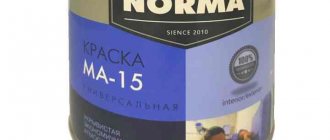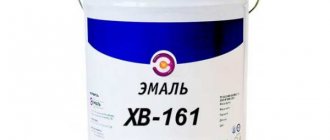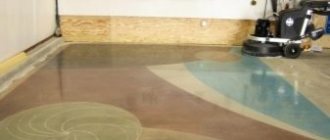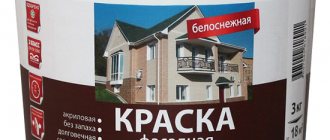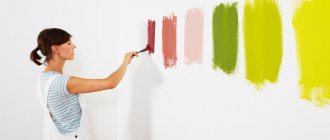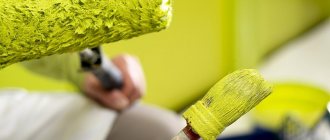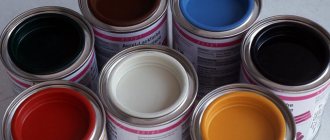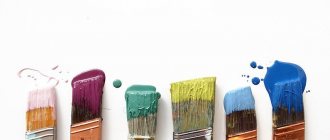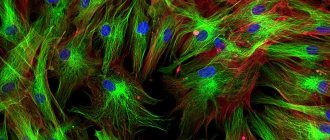Acrylic paints for walls and ceilings from San Marco fully meet the requirements of the international market. They are known in the field of construction and renovation, in the field of restoration of architectural landmarks and restoration. Interior acrylic paint can be used by both professionals and amateurs.
Like all products of the Italian manufacturer, acrylic paints from San Marco differ:
- Strength and durability. During operation, the coating does not lose color saturation.
- Environmentally friendly. The paints are hypoallergenic.
- Security. They are waterproof, fireproof, and resistant to sunlight.
- Functionality. Masks minor defects.
Water-dispersed acrylic paint for walls: features, properties and scope of application
Acrylic paints are also called water-dispersion paints. They contain a polymer acrylic dispersion and pigment. Acrylic dispersions are made from acrylic resins, which determine the technological properties of the paint, its resistance, durability, etc. It is allowed to dilute acrylic paint with water, which is the base of the paint. After applying the material to the surface, water molecules will begin to evaporate and resin particles will merge, forming a wear-resistant, durable and colorful layer. Pigment gives the material opacity and color.
Disadvantages of acrylic water dispersions
Water-dispersion paint cannot be stored at sub-zero temperatures; under such conditions, the composition loses its properties and the coating may delaminate. There are also several factors that sometimes cause difficulties when carrying out facade finishing work.
It is not recommended to paint exterior surfaces in the following weather conditions:
- temperatures below +5 °C will not allow the formation of a protective film and will lead to the appearance of cracks in the coating;
- the scorching sun (direct rays) prevents the uniform distribution of the composition over the surface; the solution dries too quickly, streaks, spots and unevenness appear;
- the slightest precipitation will ruin a freshly painted wall; even potentially washable paint must dry for at least a day, then the coating will become durable;
- acrylic dispersion does not form a film at relative humidity above 80%; the water simply does not evaporate;
- gusty winds contribute to uneven drying of the applied composition, as a result of which various visual defects appear.
Features and characteristics of acrylic paints
Acrylic paints for painting walls are intended for decoration inside residential and industrial premises. The prevalence of such paints is due to their excellent characteristics:
- no unpleasant odor;
- low toxicity;
- high drying speed;
- the ability to obtain a variety of shades by combining pigments;
- resistance to moisture;
- possibility of wet cleaning and cleaning of the resulting layer.
For a small surface, you can use aerosol paints. Material consumption can be reduced by first applying a layer of high-quality primer, such as Tintofis. For repairs and construction, paints in cans are used; for artistic crafts, acrylic paints in tubes are used.
Professional secrets for interior work
The paint can be used for indoor work, but the requirements must be followed. After covering the walls, the humidity level in the room increases. To quickly harden the layer, you need to install a fan.
To obtain an even coating, you must follow the following rules and recommendations:
To evenly cover a plastered façade, at least 3 layers of paint are required.
- application from top to bottom;
- first use a brush to paint over all hard-to-reach areas and irregularities;
- wait 4-5 hours between applying each layer;
- if the surface absorbs the material quickly and well, it is covered with 3-4 layers;
- before work, the plinths are removed;
- If you plan to paint the wall in several colors, you can use construction tape.
Ready-made stencils are intended for decorating walls. Recently, special rollers have appeared, the surface of which has a texture. They are used to create complex decorative elements.
Types of acrylic paint
Water-based acrylic paints for interior work, depending on their purpose, are divided as follows: for rooms with normal humidity conditions and for rooms with high humidity levels (kitchens, bathrooms, etc.). Based on their resistance to physical impact, washable and impact-resistant paints are distinguished. There are universal (combined) paints, for example, Valmarana Premium Matt, which are used for painting both ceilings and walls. There is also decorative paint for the ceiling on sale; this paint is notable for its low price, but it is not intended for wet rooms or walls that require frequent washing.
Interior acrylic paints are also divided into:
- Glossy. They shine brightly and beautifully (for example, Markotek AU). It should be used on a wall or ceiling with a perfectly smooth surface.
- Matte. A universal option that is suitable for ceilings and walls (examples: Armonia or Laguna). A discreet, delicate coating that emphasizes the elegance of the interior.
- Mother of pearl. To achieve a relief effect. Perlacheo paint is suitable for adding extra shine and personality to a room. Pearl effect paint for walls can also be applied with painting tools, such as a spatula or trowel, for a visual representation of the decorative effect. Or even serve as a protective glazing composition.
Textured paints can be classified into a separate category. They are more labor-intensive to apply, but will help create various effects on the wall. The most popular texture paints are:
- metallic effect paint;
- silk effect paint;
- sand effect paint.
Water based paints
Water-dispersion paints are produced, in the vast majority of cases, in white color, which makes it possible to achieve any shade (including imitation gold, silver, platinum, etc.) by adding special tinting dyes (colors).
You can tint the paint immediately before use, so to speak, manually, but it is difficult to achieve the required shade and, even more difficult, if necessary, to repeat it.
Therefore, if you are planning a large amount of work, it is better to use a special tinting machine, which allows you not only to obtain any required amount of paint of the desired color, but also to repeat this color if necessary. To select the desired shade, all the world's leading paint manufacturers have their own color cards, where each shade is assigned its own number.
Water-dispersion acrylic facade paint
The properties of water-dispersion paints and varnishes and their cost depend on which polymers were used as a binder.
Acrylic dispersions probably make up the majority of all water-dispersion paints and, despite their higher cost, are most often used for finishing interiors, facades, etc.
They have universal qualities and high performance indicators, they allow you to achieve almost any shade (over 15 thousand are declared) and at the same time perfectly retain color even under conditions of intense ultraviolet irradiation.
Water-dispersion (often incorrectly called water-based or latex) varnishes and paints are becoming increasingly widespread. They have practically replaced traditional oil paints, which were previously used for interior decoration. Water-dispersed compositions do not contain solvents, are practically odorless, are highly manufacturable (easily applied with a brush, roller and spray), have excellent adhesion to almost all building materials and have high performance characteristics.
Unlike most solvent-based paints, water-dispersion compositions form a vapor-permeable coating (breathe), which has a beneficial effect on the microclimate of the room. When purchasing paint, it is much more important to find out its primary purpose in relation to operating conditions.
Paints can be classified by:
- composition,
- properties,
- areas of application,
- flowers.
Manufacturers of real high-quality paint are interested in its professional use and assessment of its properties from the point of view of a protective and long-term coating when processing various surfaces, especially building facades, since in this case all the good and bad qualities of the paint coating are revealed especially clearly.
The main advantage of water-dispersion paints is that the binders included in their composition are dispersed in the form of tiny particles in water, and are not dissolved in more expensive, toxic or flammable organic solvents.
In addition to a film former (synthetic resin) with various fillers and pigments, the composition of such paint also includes a number of special emulsifier additives that promote the formation of paint droplets in water, dispersion stabilizers, thickeners, antifoaming agents, antiseptics and much more.
They are characterized by:
- hydrophobicity (water-repellent effect),
- elasticity,
- good mechanical strength.
The undoubted advantages of these paints are environmental friendliness, high technological parameters and water as a diluent. In terms of performance properties, acrylate-based water-dispersion paints are recognized as the best. Abroad, paints of this type account for up to 90% of all materials produced.
Table. Characteristics of paints according to GOST.
| Characteristic | Water-dispersion paint | Acrylic water-based paint | Water emulsion with latex |
| Name according to GOST | VD-VA-224 | VD-AK-111 | VD-KCH-26 |
| Frost resistance, number of cycles | At least 5 | — | — |
| Grinding degree, µm | No more than 30 | No more than 60 | No more than 70 |
| Covering power of the dried film, g/m2 | Up to 120 | Up to 100 | Up to 210 |
| Film resistance to constant water exposure, hours | From 12 | — | From 24 |
| Mass fraction of non-volatile substances | About 56% | About 55% | About 59% |
Where is acrylic paint used?
Water-dispersed acrylic paint for walls and ceilings is not produced for a specific type of room; the paint is selected according to its intended purpose (for example, facade, especially resistant for places where the surface often gets wet, etc.). High-quality acrylic is practically not afraid of moisture, so water-based acrylic wall paints are successfully used in bedrooms, living rooms, kitchens, and baths. You can finish with acrylic directly using:
- tree,
- cinder block,
- brick slab,
- concrete slab.
There is a special type of San Marco acrylic paint for application to metal surfaces - Unimarc Smalto Micaceo. Preliminary puttying of irregularities and defects will help improve the appearance of the treated surface.
Series of paints and their characteristics
The stores sell paints of different brands. All of them have certificates of conformity and are manufactured in accordance with GOST or TU standards. Paint manufacturers - NPO KraskaVo, VGT and many others.
VD-AK-1180
Facade paint VD-AK-1180 is used for painting building facades and carrying out other external facade work; it can also be used for indoor interiors - walls and ceilings. The material is frost-resistant, perfectly retains its decorative properties under the influence of precipitation and other adverse conditions. VD-AK-1180 is not suitable for floors.
The technical specifications are:
- coating surface – smooth, matte, color white, yellow, green and others;
- quality of coating – moisture-resistant, breathable;
- the material has a subtle apple scent;
- drying time – 1 hour;
- consumption 65 g/sq. m;
- permissible amount of solvent (water) – up to 5%.
The product is available in 1.5 kg packaging. If you add too much dilution water, the material turns greyish. The product is applied after cleaning the wall of old paint with a roller, brush, or spray gun; usually one layer is enough.
VD-AK-2180
VD-AK-2180 enamel is available in different modifications - regular interior paint and VGT superwhite enamel VD-AK-2180 for ceilings. The material is widely used for application on ceilings, walls, wallpaper in dry rooms - in bedrooms, living rooms, children's rooms, public places. After application, a porous coating layer is obtained that does not reduce breathability. At the same time, the density of the layer is high, it is resistant to mechanical damage.
The description of the parameters and properties of the tool are as follows:
- excellent adhesion;
- absence of streaks and drips;
- Can be used on any surface material;
- snow-white color, no odor;
- good hiding of wall unevenness;
- hypoallergenic;
- resistance to cold;
- consumption – 160–180 g/sq.m. m;
- drying - 1 hour, complete drying - 24 hours.
When working with enamel, you must observe fire safety and wear gloves on your hands to protect your skin. The material can be applied in any convenient way, having previously primed the surface.
VD-AK-111
This brand of product will be useful to those who want to create a beautiful coating for the facade of a building that will withstand cold temperatures and temperature changes for 3-5 years. Textured paint VD-AK-111 is an environmentally friendly, high-quality material that is very economical and easy to use . The product is applied to surfaces made of concrete, metal, brick; they can first be plastered and primed.
Specifications:
- drying time – 1 hour at air temperature +20 degrees;
- consumption per layer – 100–150 g/sq.m. m;
- color – white, can be tinted if desired;
- high levels of hiding power, water resistance, light fastness;
- withstands temperature changes of –50…+60 degrees.
VD-AK-114
The material for facades and interiors VD-AK-114 can last more than 10 years, so it is used for application to prepared external surfaces of buildings. The product is also suitable for use in damp rooms, for use in buildings with high hygienic requirements - in hospitals, gardens, pharmaceutical and food industries. This material can be used for the restoration of monuments.
Paint properties:
- odorless, non-explosive and non-flammable, non-toxic;
- forms a durable matte finish;
- adheres perfectly to any type of material;
- has high hiding power, whiteness, weather resistance, and can withstand wet cleaning;
- repels dirt;
- dries in 1 hour;
- consumption – 60–100 g/sq.m. m.
VD-AK-101
Water-dispersion enamel VD-AK-101 is intended for treating various porous surfaces - brick, concrete, wood, fiberboard (any except the floor). A variety of the product VD-AK-101Sh is also produced, which gives a silky coating effect.
Material properties:
- excellent adhesion indicator;
- resistance to atmospheric conditions;
- moisture resistance;
- no unpleasant odor;
- easy cleaning of the coating;
- obtaining a breathable layer;
- conditional viscosity – 20 s using a VZ-246 viscometer;
- shades – white, beige, pistachio, blue;
- drying time – 1 hour at a temperature of +20 degrees;
- grinding degree – 40–50 µm.
The material goes well with putties of the VD-AK series and primers of the same marking.
VD-AK-449
This product is intended for painting concrete and wood floors that are subject to high friction and wear out quickly. Typically, VD-AK-449 is used in housing, in basements with moderate levels of humidity, and in utility rooms.
Characteristics and properties:
- coating – uniform, semi-matte;
- shade – red-brown, yellow-brown;
- coating service life – up to 5 years;
- consumption per layer – 200–250 g/sq.m. m;
- drying time – 3 hours, floors can be washed with detergents after 14 days;
- dilution – with water (up to 10%).
Apply the paint with a roller or brush, and the room temperature should not deviate greatly from +5 degrees, humidity should not exceed 80%.
What is included in acrylic paint
The classic composition of acrylic paints: filler, binder, coloring pigment. The binder is an acrylic polymer dispersion of acrylic resins. The colorful palette of the material is created by finely ground pigment, which, when mixed with a binder, remains suspended without dissolving. During long-term storage, separation of the mixture may occur: at the bottom of the jar there is a coloring pigment, on top there is an emulsion. Before starting work, the contents are thoroughly mixed.
The final properties of the material depend on the components: fillers, pigments, various additives (plasticizers, hardeners, antifoams). To improve adhesion, matting, and strengthen the paint film, filler (large pigment particles) is added. The viscosity of the paint is reduced by a solvent - water or an organic thinner.
With the help of additives (auxiliary components), the structure of water-based acrylic paint or paint film is changed after painting. There are additives that affect drying speed, transparency, thickness, etc.
Compound
The high environmental friendliness of the material is primarily due to the absence of organic solvents in the composition; The product is diluted exclusively with water.
The solution also contains coloring substances (pigments), binding components (guaranteeing the strength of the coating), fillers (usually talc, chalk or marble flour).
Sometimes during production, fire retardants (substances that prevent the combustion process), driers (promote rapid drying of the composition) and other additional elements are added that improve the quality of the coating.
How to dilute acrylic paints
Water-dispersed acrylic paint for walls has a fairly thick consistency, so for ease of application it is diluted before starting work. Another reason for paint thinning is that it remains open for too long.
The main diluent is water. Moreover, after applying paint to the surface, the coating will become waterproof.
The use of a thinner can significantly change the properties of acrylic paint, including:
- color and shade;
- layer strength;
- surface view.
To get the desired result, you must use thinners recommended by the manufacturer.
Acrylic VDK for external use
To organize work outdoors, you must wait for favorable weather conditions.
When applying a layer of acrylic VDK, it is important to follow the following rules:
- High humidity levels contribute to the destruction of the coating. After application, a protective layer will not appear, so the paint will not be able to dry completely.
- Work is not carried out in windy weather. There is a possibility of sand or small debris sticking to it.
- Exposure to direct sunlight will cause paint to set unevenly. During hot periods, it is recommended to create artificial shading. It will be easier for the master to work, defects during application can be avoided, and drips can be removed.
Acrylic paint must be applied according to the instructions.
Sequence of work:
After cleaning, the facade must be primed with a specialized deep penetration compound.
- First, remove all stains and dirt from the surface. It is recommended to use a degreaser.
- All irregularities are leveled out. You can use putty, cement-sand mortar, and plastering the walls.
- Areas with mold are treated with rags and removed with sandpaper. A fungicide is applied to problem areas.
- When painting for the first time, the walls are pre-primed with a roller or brush. The primer dries within 14 hours.
- The paint is thoroughly mixed before use. You can give the desired shade by adding color or mixing several pigments.
After hardening, the layer of material becomes durable and cannot be washed off. For personal safety, wear gloves or treat the skin with a thick cream.
How to calculate acrylic paint consumption per m2
The manufacturer indicates paint consumption on the packaging. However, it is worth considering that the consumption rates are indicated for ideal conditions, a smooth surface and in a thin layer. In practice, the roughness and absorbency of the surface, as well as the method of application (roller or spray gun), are of great importance. It can be assumed that 5-15% more paint will be needed than what is written on the package.
Paint calculations are made after determining the area of the surface to be painted. Next, the area is divided by the standard flow rate. The result is the amount of material required for application in one layer. Paint consumption per 1 m2 can also be calculated using online calculators available on the Internet.
Features of application
When using paint you need to know some nuances. If it is raining or frosty outside, then painting work cannot be carried out, the solution will not dry. In hot weather, the paint will dry so quickly that it can degrade the quality of the coating.
Before using paint, you need to level the surface to perfect smoothness. A thin layer of coating will highlight all the protrusions and “notches” on the wall.
Acrylic paints for decorative wall painting
Thanks to a wide palette of colors and high practicality, acrylic paints for painting walls and rooms have opened up a whole direction in wall decoration. Acrylic mixtures used in artistic painting are an aqueous dispersion of acrylic resins. Functional components provide the paint with additional properties: aesthetics, stability, strength after drying, resistance to high and low temperatures. Such paints can create a variety of three-dimensional visual effects, add relief and depth to the surface.
The selection of the required paint shades in specialized centers is done using a catalog, where each color has its own code.
Drawings are applied to the surface of the car using acrylic paints. With their help, chic patterns are made on a coating made using acrylic monomer.
General information about water-dispersed materials
Paint and varnish materials for construction purposes
Water-dispersed paints and varnishes (hereinafter LKM, or VD LKM) have long been known abroad. The first developments date back to the twenties of the now past century; their further development was prevented by the Second World War. Immediately after the war, active promotion of products based on this type of binder began outside the borders of our Motherland.
Types of acrylic-based paints from San Marco
The range of acrylic paints from the Italian manufacturer San Marco is quite wide. The company produces interior paints (for interior work) and facade paints (for exterior work). San Marco produces innovative paints that meet modern requirements.
They fit well on the surface being treated, creating a uniform layer, and are characterized by long-term operation. You can choose glossy or matte paint that is impact-resistant, washable, moisture-resistant, high-performance, and at a cost that will fit your budget. All paints from this brand are of high quality.
How to choose good quality material?
In addition to the usual recommendations, such as checking the certificate or choosing well-known brands, you can use one more tip: you should not buy colored acrylic water-based paint.
One of the main indicators of the high quality of the composition is its original whiteness; The whiter the solution, the higher the likelihood of obtaining a reliable and durable coating. During production, color is often added to hide a defect, so it is better to create the desired shade yourself.
In any case, the material will have to be diluted with water and mixed thoroughly (it is sold in a paste form), tinting can be added to this process.
How to paint walls or ceilings with acrylic paint
If you decide to do the painting yourself, but do not have the technique of a master, you should familiarize yourself in detail with the procedure for performing the work and the properties that acrylic enamel paint has. This modern material is used to create different interior styles, including Art Deco, which is characterized by high aesthetics and luxury. The colors of acrylic paints from the San Marco brand make it possible to emphasize interior features by selecting the desired tone. At the same time, the material will protect the walls from the appearance of mold and mildew.
To ensure good adhesion, the base is carefully prepared:
- you need to clean and wash off the old coating;
- apply putty, sand it;
- get rid of dust;
- apply primer.
Prepare the composition of the required thickness. The paint thinner is water. The ceiling is processed first. The correct execution of further steps involves painting it in one go, so that the acrylic paint does not dry out and its transition is not visible. This can be attributed to the disadvantage of this material.
Correctly selected, high-quality tools play an important role:
- special bath;
- rollers;
- tassels;
- sponge.
Nothing better has been invented yet than acrylic paints
Coatings formed with acrylic paints are practically harmless: they have high resistance to UV radiation, elevated temperatures, and extremely high oil, water, and salt resistance. Moisture-resistant acrylic paint does not peel off or crack even on problematic surfaces. It comes in glossy, semi-gloss, matte, semi-matte, and dazzling white. The stability of the gloss gloss can be traced throughout the entire period of operation.
Other advantages include: excellent coverage, economical consumption, formation of a vapor-permeable coating, environmental friendliness, tinted in any shade. This paint will solve any problem.
Benefits of paint
The water-dispersion solution has a number of positive qualities. First of all, it is an environmentally friendly coating because it is water-soluble. It does not have a strong odor and is breathable. Thanks to this latter quality, the material under the coating does not rot or mold.
Several more characteristics can be highlighted:
- Water-based paints do not burn, so they are considered fireproof.
- They are easy to apply; even a beginner can handle this material.
- They last up to 15 years, which means that the surface does not have to be repainted annually.
- The solution dries quickly. After applying the first layer, only 2-3 hours should pass.
- Brushes and rollers can be wiped off with water and detergent after use.
- Due to its moisture resistance, the solution is excellent for treating wooden surfaces outdoors.
- The coating is resistant to damage.
- The paint is affordable.
With so many positive factors, there are also application features that should be adhered to.

